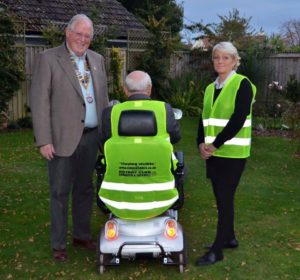
Response to my challenge.
I recently challenged 11 mobility scooter manufacturers to make their scooters highly visible as standard. So far, I have only received one response and I think you will find the following of interest as I did.
Mobility scooters do not have to have insurance as standard and the ones that travel up to 4mph do not have to display any high viz apart from small reflectors, red at the rear, white at the front and blue on the sides. Most of us who have seen these reflectors would agree they are wholly inadequate.
For scooters that travel on the roads, these are supposed to display a flashing amber beacon on a pole. I for one have never seen this happen.
Many people purchase a scooter when their GP advises them they are no longer fit to drive. There is still a degree of pride and kudos in the choice of mobility scooter and I was told a high viz vest screams ” I am elderly or disabled” not ” Be safe, be seen”. Madness this vanity.
When asked if some reflective scotch tape could be applied by manufacturers the answer was – If we do that it costs us £10. By the time this gets to the dealer this is £50 and if they pass that onto the customer they will lose business to a competitor who may be cheaper. The analogy was the match seller flourishes whilst the fire extinguisher seller goes out of business.
So it’s down to Pride and Profits that people are unnecessarily being killed. In 2015 there were 9 deaths and 46 serious injuries to scooter users.
The only way forward is Legislation, to make it compulsory for all scooter users to make themselves as visible as possible. Perhaps retailers could also assume a social responsibility too, great advertising opportunity and chance to save lives.

I perhaps should have added that in early retirement the main motive for me for buying an electric bike was that I had a travelling job using the car, –which gave me an arthritic left knee by over use of the clutch in traffic. The bike took the weight off my body when exercising (and for the same reason I swim) I should have gone automatic earlier! -exercise using an electric bike strengthens the muscles around the “synovial sack” around the joint. I can now walk much further than before!
Another motive was to prepare myself for the time when driving is no longer possible. I found that fitting a bike out with suitable basket and panniers and also wing mirrors is a major problem holding the electric bike industry back (as is the barrier problem already mentioned) The designers of the electric bike industry are “Sport mad” and do not think of these things. I case you are interested they also cannot control their skills in producing decent operating electronics with correct operator interface design completely ignored. Nobody has a simple on/off switch for the lights nor a simple to operate re-set for the mile-meter.
I hope these comments may be of use when others are going for the electric bike option in earlier years of retirement.
Please do, I would be interested in their response.Thank you.
Yes, but it was only a day ago, so it’s early days yet!
If anything happens I will let you know.
A very good point to raise Andrew, thank you. The very purchase designed to provide independence hampered by poor design of barriers. Have you raised this with your local councillors ?
Another problem when purchasing both mobility scooters and electric bikes is that they may not always go though the barriers on some off road routes. For example the barriers at the beginning of the trans pennine way within urban areas are not of a consistent design and a given vehicle cannot easily be selected for travelling here because of the size problem. This also effects the purchase of electric bikes by the elderly. -lack of standardisation of these barriers. buy the wrong vehicle and you have problems!